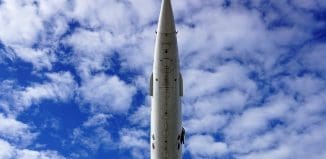Syrian Strikes Would Battle-Test Chinese Radars
This post is also available in:  עברית (Hebrew)
עברית (Hebrew)
 Unidentified air forces have performed attacks in Syria in recent years with no early detection. According to the foriegn press the aircraft were operated by the Israeli air force.
Unidentified air forces have performed attacks in Syria in recent years with no early detection. According to the foriegn press the aircraft were operated by the Israeli air force.
If this is the case, then the Israelis know the operational capabilities of the Chinese radars supplied to Syria.
Now it’s the turn of the Americans.
If the U.S. strikes Syria, China would get to see just how well some of its radars and electronic warfare (EW) emitters perform in combat.
Among the Chinese systems deployed by the Syrian military are the JYL-1 3-D long-range surveillance radar, Type 120 (LLQ120) 2D low-altitude acquisition radar, and JY-27 VHF long-range surveillance radar, according to Richard Fisher, a senior fellow with the U.S.-based International Assessment and Strategy Center.
According to Defense News, China would no doubt digest any performance data for use in a potential conflict with the US, which could be sparked by disputes over Taiwan, Senkaku Island or the South China Sea.
But the lessons would flow both ways. The Pentagon would scoop up wartime electronic emissions from the Chinese systems, and moreover, could test its own methods of countering the kind of anti-access/area denial (A2/AD) strategies and technologies that China is developing.
iHLS – Israel Homeland Security
Fisher said the multiple types of Chinese radar strongly suggest that Beijing has been “providing much of the secure electronic infrastructure critical to the regime’s survival.”
He said Beijing has, in the past, used Chinese telecommunications firms to “militarily support its dictator clients” against the U.S. In the late 1990s, such firms linked Saddam Hussein’s radars via fiber-optic cables to better target U.S. aircraft enforcing the U.S. no-fly zone.
“American fighter-bombers were actually bombing these cable nodes, that the Chinese would then rebuild,” he said.
A more urgent question is just how much of a threat the Chinese-augmented air-defense system would pose to attacking US planes.
Syria has 120 surface-to-air missile (SAM) sites armed with a mix of Russian and old Soviet systems: SA-2, SA-3, SA-5, and SA-6. It has 50 EW facilities with a mix of Chinese and Russian systems, said Sean O’Connor, editor of IMINT & Analysis, a US-based newsletter.
Modern Chinese EW radars can detect US low-observable aircraft and perhaps even very-low-observable ones, O’Connor said. Particularly effective are the two 500-km JY-27 radars delivered in 2006, now deployed north and south of the city of Palmyra in central Syria.
“The range of the JY-27 permits either site to monitor the bulk of Syrian airspace, along with a significant amount of the surrounding region,” he said.
Little is known directly about the less-capable Type 120 radar, but it is a derivative of the JY-29/LSS-1 2D radar, which can track 72 targets out to 200 km.
“The more refined Type 120 may improve on these specifications, but they are a logical baseline,” O’Connor said.




























